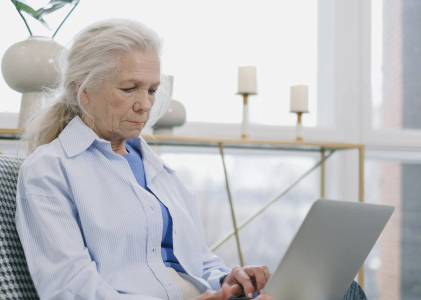The FDA is warning patients about online health ads—here’s why it matters
By
Veronica E.
- Replies 0
If you spend any time online, you’ve likely seen ads promising quick weight loss, cheaper medications, or “the same results as Ozempic for less.”
Some even come from telehealth companies that have become household names during the past few years.
For many, the convenience of online healthcare feels like a breakthrough—no waiting rooms, no long drives, just quick access to a prescription.
But now, federal regulators are raising concerns.
According to the Food and Drug Administration (FDA), not every claim made in these ads is trustworthy, and some could put patients at real risk.

The pandemic turned telehealth into a lifeline, especially for older adults.
Virtual visits offered comfort and convenience at a time when in-person care was difficult.
But as the industry grew rapidly, so did the opportunities for misleading advertising.
The FDA has begun cracking down on telehealth providers and compounding pharmacies for what it calls “false and misleading” statements, especially about compounded GLP-1 drugs.
These are copycat versions of well-known medications such as Ozempic and Wegovy, prescribed for type 2 diabetes and weight loss.
Approved GLP-1 medications go through years of testing to confirm their safety, quality, and effectiveness.
Compounded versions, by contrast, are mixed by certain pharmacies when shortages occur.
While this practice can sometimes help fill gaps in supply, compounded drugs are not FDA-approved and may contain ingredients the agency has not reviewed.
That means patients cannot be sure they’re receiving the same standards as the brand-name drugs.
Over the past year, the FDA has sent more than 100 warning letters to telehealth companies and compounding pharmacies.
One high-profile example involved Hims & Hers, which advertised compounded products as containing “clinically proven ingredients” and being equivalent to brand-name drugs.
Regulators say such claims mislead consumers and create false confidence.
The central concern is that patients may believe they’re getting the same treatment as an FDA-approved drug when, in reality, there’s no guarantee of quality or safety.
In 2024, the FDA reported a rise in adverse events tied to compounded GLP-1 drugs.
The most common problem was dosing errors, often because of confusing multi-dose vials.
Some patients accidentally took far more than the intended dose—up to 20 times in one case—leading to severe nausea, vomiting, and dehydration.
Others were hospitalized after using compounded products that had unclear instructions.
Because compounded drugs lack standardized testing, even the correct dose can vary in strength or quality. That uncertainty adds to the risk.
Staying safe while using telehealth services doesn’t mean avoiding them altogether—it means asking the right questions and knowing what to look for:
Telehealth is here to stay, and for many people, it has made healthcare easier and more accessible.
But as the FDA’s warnings make clear, not every service is equally safe or transparent.
Asking questions, reading the fine print, and consulting trusted healthcare providers are some of the best ways to protect both your health and your wallet.
Read next:

Have you ever used a telehealth service to order medication? Did you feel confident in what you received, or did it raise questions for you? Drop a comment below and share your experience with The GrayVine community.
Some even come from telehealth companies that have become household names during the past few years.
For many, the convenience of online healthcare feels like a breakthrough—no waiting rooms, no long drives, just quick access to a prescription.
But now, federal regulators are raising concerns.
According to the Food and Drug Administration (FDA), not every claim made in these ads is trustworthy, and some could put patients at real risk.

Online telehealth ads have become more common, but the FDA is cautioning patients to review claims carefully before trusting them. Image Source: SHVETS production.
Telehealth’s growth—and growing pains
The pandemic turned telehealth into a lifeline, especially for older adults.
Virtual visits offered comfort and convenience at a time when in-person care was difficult.
But as the industry grew rapidly, so did the opportunities for misleading advertising.
The FDA has begun cracking down on telehealth providers and compounding pharmacies for what it calls “false and misleading” statements, especially about compounded GLP-1 drugs.
These are copycat versions of well-known medications such as Ozempic and Wegovy, prescribed for type 2 diabetes and weight loss.
Also read: FDA warns: Cookies with cancer-linked ingredients pulled from shelves
What makes compounded GLP-1 drugs different
Approved GLP-1 medications go through years of testing to confirm their safety, quality, and effectiveness.
Compounded versions, by contrast, are mixed by certain pharmacies when shortages occur.
While this practice can sometimes help fill gaps in supply, compounded drugs are not FDA-approved and may contain ingredients the agency has not reviewed.
That means patients cannot be sure they’re receiving the same standards as the brand-name drugs.
Also read: FDA under fire for withholding outbreak details—Here’s why it matters.
Why the FDA is stepping in now
Over the past year, the FDA has sent more than 100 warning letters to telehealth companies and compounding pharmacies.
One high-profile example involved Hims & Hers, which advertised compounded products as containing “clinically proven ingredients” and being equivalent to brand-name drugs.
Regulators say such claims mislead consumers and create false confidence.
The central concern is that patients may believe they’re getting the same treatment as an FDA-approved drug when, in reality, there’s no guarantee of quality or safety.
Also read: Nature’s way, so no prescription is needed: How diet can mimic the effects of Ozempic
When “cheaper” becomes riskier
In 2024, the FDA reported a rise in adverse events tied to compounded GLP-1 drugs.
The most common problem was dosing errors, often because of confusing multi-dose vials.
Some patients accidentally took far more than the intended dose—up to 20 times in one case—leading to severe nausea, vomiting, and dehydration.
Others were hospitalized after using compounded products that had unclear instructions.
Because compounded drugs lack standardized testing, even the correct dose can vary in strength or quality. That uncertainty adds to the risk.
Also read: Medicare may soon cover medications for weight loss—here’s what to know about the proposed program
How to protect yourself
Staying safe while using telehealth services doesn’t mean avoiding them altogether—it means asking the right questions and knowing what to look for:
- Be cautious with bold claims. If an ad promises miracle results or “the same drug for less,” approach carefully.
- Ask about compounding. If you’re offered a compounded drug, find out where it was made and whether the pharmacy is accredited.
- Look for disclaimers. Any legitimate telehealth provider should make clear whether a drug is FDA-approved.
- Check with your doctor. Always talk to your primary care provider or pharmacist before starting something new.
- Report suspicious ads. The FDA’s MedWatch program accepts reports of misleading or unsafe advertising.
Telehealth is here to stay, and for many people, it has made healthcare easier and more accessible.
But as the FDA’s warnings make clear, not every service is equally safe or transparent.
Asking questions, reading the fine print, and consulting trusted healthcare providers are some of the best ways to protect both your health and your wallet.
Read next:
- Warning: Most online pharmacies might be dangerous—here’s what you need to know to protect your health
- The online "doctor" you’re watching might not be real
- Beauty scandal alert: Could your botox be fake?
Key Takeaways
- The FDA has issued more than 100 warnings to telehealth companies and compounding pharmacies about misleading claims, especially around compounded GLP-1 weight loss drugs.
- Unlike brand-name medications such as Ozempic and Wegovy, compounded versions are not FDA-approved and may carry safety risks.
- Reports of serious dosing errors and hospitalizations have been linked to compounded GLP-1s, often due to unclear instructions.
- Patients are encouraged to check drug approval status, ask about compounding practices, consult their doctor, and report suspicious ads.
Have you ever used a telehealth service to order medication? Did you feel confident in what you received, or did it raise questions for you? Drop a comment below and share your experience with The GrayVine community.






